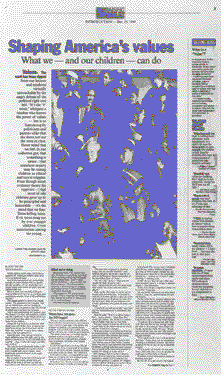| “Civic Journalism is a fresh label on an old idea — that journalism has an obligation to provide people with the news and information they need to make the decisions they are called upon to make. In a self-governing society, it helps people behave as citizens.” Ed Fouhy, Executive Director, Pew Center for Civic Journalism Batten Symposium, September 13, 1996 |
What makes civic journalism different from every-day good journalism? Civic journalism is everything that good journalism is — but it’s also a bit more.
Civic journalism is both an attitude and a set of tools. The attitude is an affirmation that journalists have an obligation — a constitutionally protected obligation — to give readers and viewers the news and information they need to make decisions in a self-governing society. The emerging tools try to help readers and viewers see how they can be active participants, not only in building news coverage, but also in building their communities.
Simply raising an alarm or spotlighting an injustice, which is traditional journalism, is not enough. Citizens these days need more help. They need to see some ways they play a role, have a voice, or make a difference — some ways they can reclaim their participation in civic life. Citizen participation, therefore, is a defining feature of civic journalism. For journalists, citizens help them do better journalism. And citizens, once invited and once engaged in a menu of opportunities, seem to be developing a civic appetite.
So how do you involve citizens and still do good journalism? Civic journalists around the country are experimenting with techniques that are making the printed page as interactive as a web site. And they are using all of the evolving new communications technologies — the Internet, e-mail, voice mail, faxes, audio text.
The journalists’ goal is to treat readers and viewers not as window dressing or passive spectators but as meaningful participants in important issues, as meaningful as the elites and the experts the journalists so often quote.
Last year’s 100 entries in the first competition for the James K. Batten Award for Excellence in Civic Journalism showed us, again and again, how editors and news directors, reporters and producers around the country were building into their news reports opportunities to interact with readers and viewers.
They were developing reporting techniques that departed from the traditional model, the one-way pipeline of information, and instead were creating opportunities for two-way information exchanges. These ideas were too good to sit on our shelves — hence this toolbox book.
Nowhere in these news pages will you see journalists trying to set an agenda or dictate solutions to community problems. You will see journalists inviting citizens to tackle community problems, to come up with ideas, recommendations, action plans — citizens’ ideas not the news organizations’. You will see no boosterism here. These stories tackle the worst pathologies in communities — crime, youth violence, economic devastation. But you will also see stories of hope, stories of great obstacles overcome, stories that convey a sense of the possibilities. As for the journalists, involving citizens in framing problems, devising solutions, and simply talking with their fellow citizens created new and richer listening posts that deepened their connections to their communities.
In part, that’s because the journalists were simply doing good journalism. They were starting their coverage where citizens start — with solid legwork on the streets and in the communities. As significant, they looked upon their readers and viewers as important as the other sources and subjects of their stories.
We hope this book gives you some good ideas and a sense of the process.
Jan Schaffer
Pew Center for Civic Journalism
March 1997
![]()
The Observer analyzed crime statistics to map the city’s highest crime areas. Then, with WSOC-TV and radio stations WPEG-FM and WBAV-AM, it launched the project with the results of a poll asking 400 Charlotte residents what must happen to make their streets safer.  
The Star was credited with a “bold and creative leap in building a year-long work of journalism around the exploration of core values” important in raising young people. A panel of experts chose the values and more than 50 of the Star’s journalists did journalism on them — “delivering compelling accounts of children’s struggles and triumphs in a most untraditional way,” the judges said. The community’s citizens were an integral part of the reporting process and the journalism “engaged thousands of citizens in thinking about their individual responsibility for making public life go better.” Even after the reporting was finished, young people in Kansas City continued the values discussion with support from the paper. Through Project Essential, a curriculum was developed that has been used in 65 elementary schools to teach such values as self-respect, self-control and respect for others. And more than 80 high schools have participated in Democracy Project discussions about the role of citizenship.
|

 In launching the project, the Star promised a year-long exploration of values that will guide the next generation. Its mission, the paper said, was “not to preach. Only to urge that the community discuss the notion of values, and do so without shame. And then teach the children.”
In launching the project, the Star promised a year-long exploration of values that will guide the next generation. Its mission, the paper said, was “not to preach. Only to urge that the community discuss the notion of values, and do so without shame. And then teach the children.”

